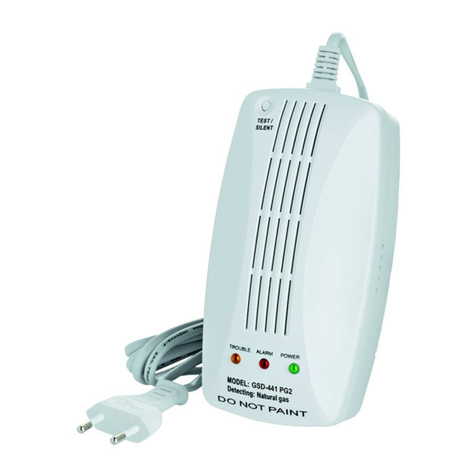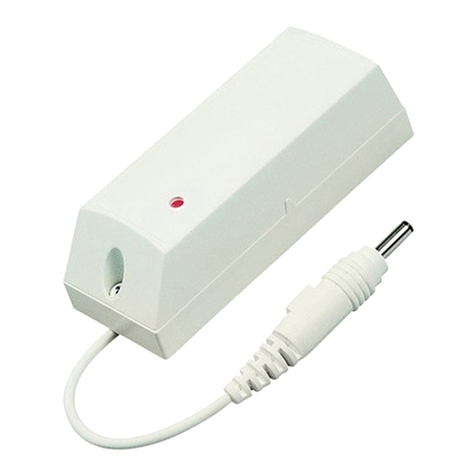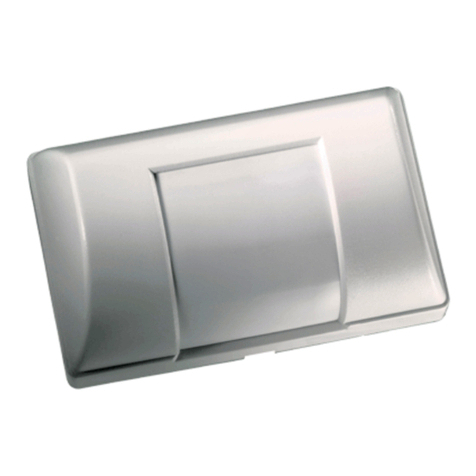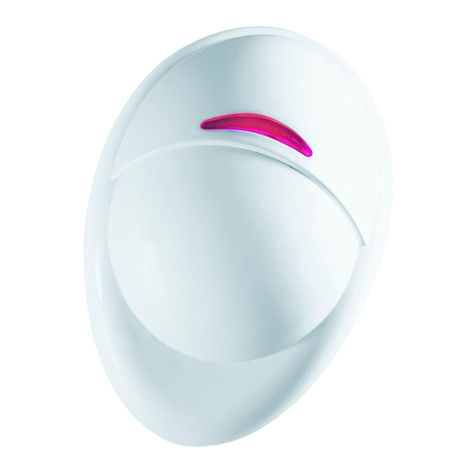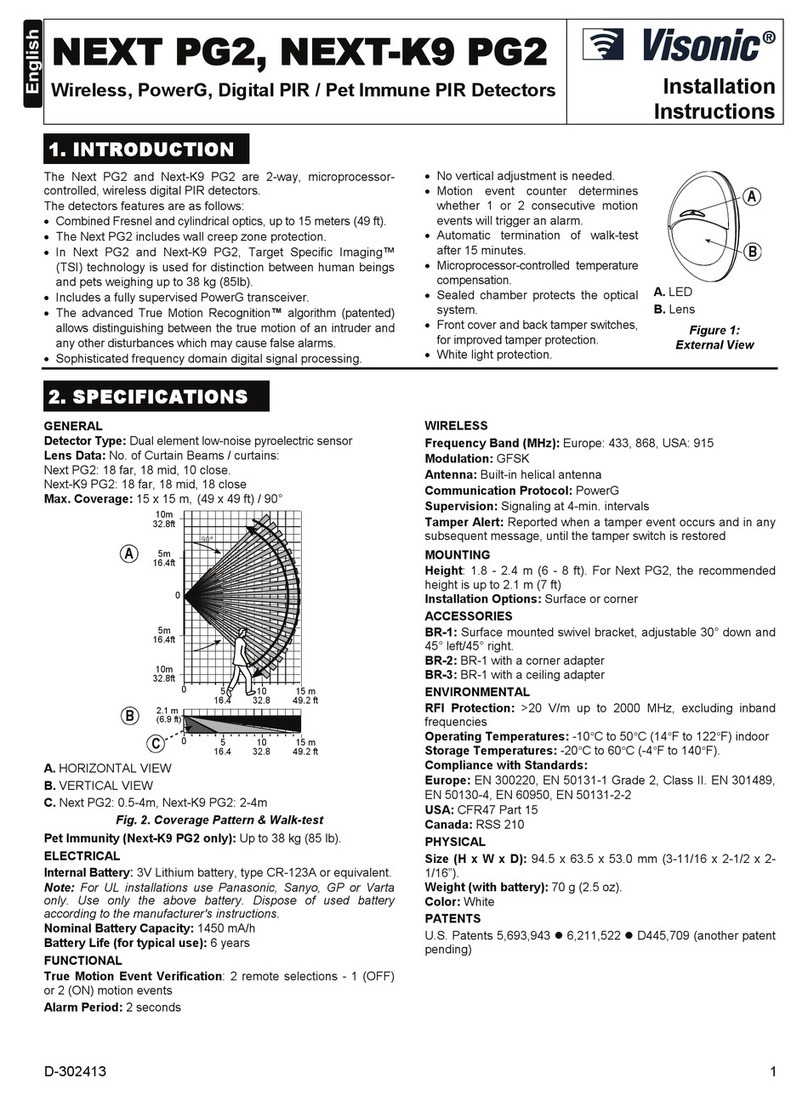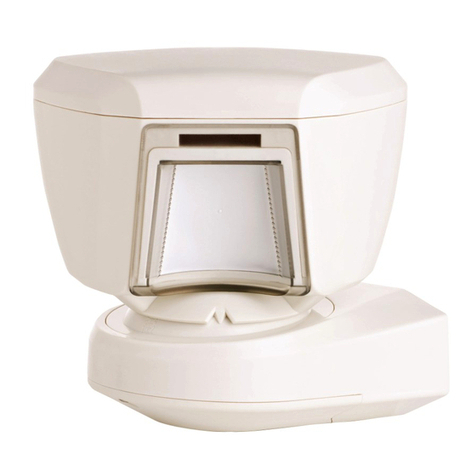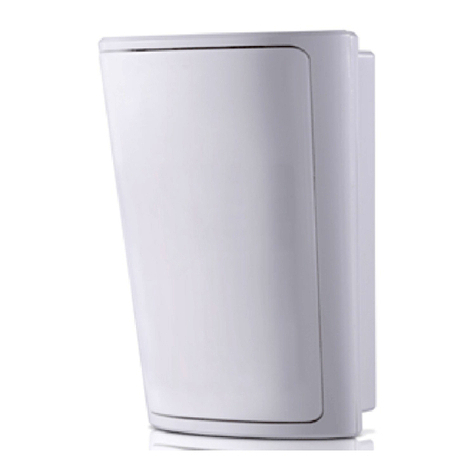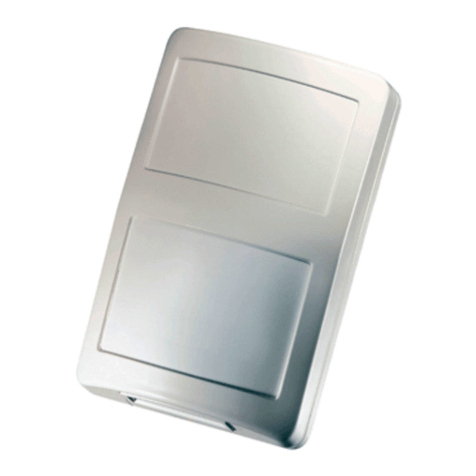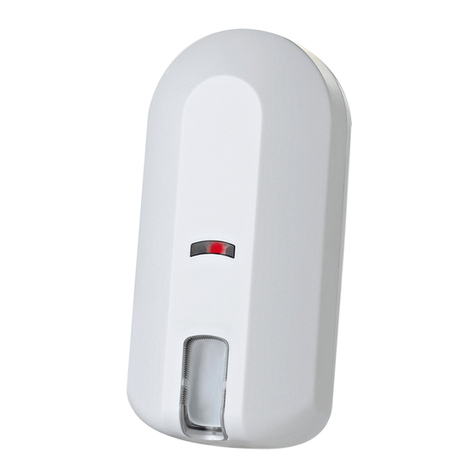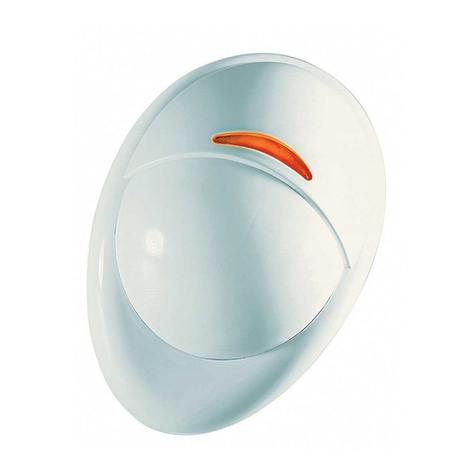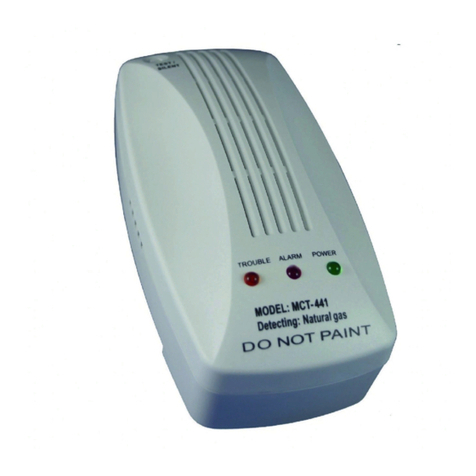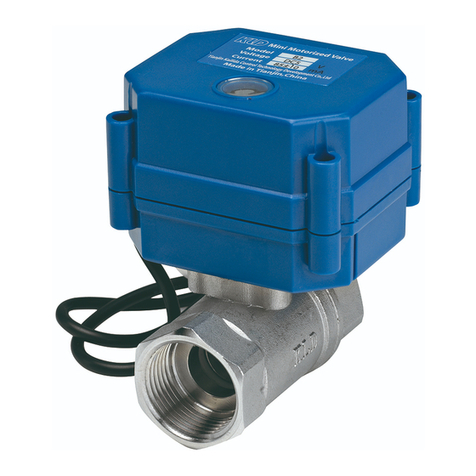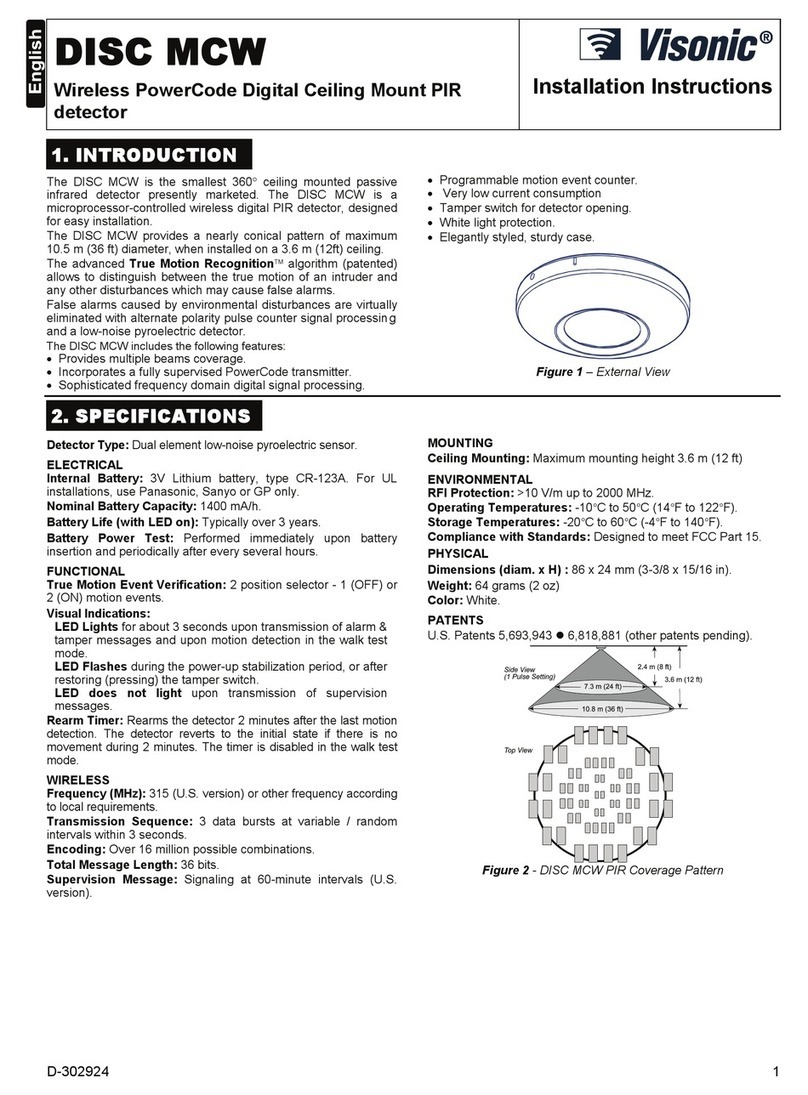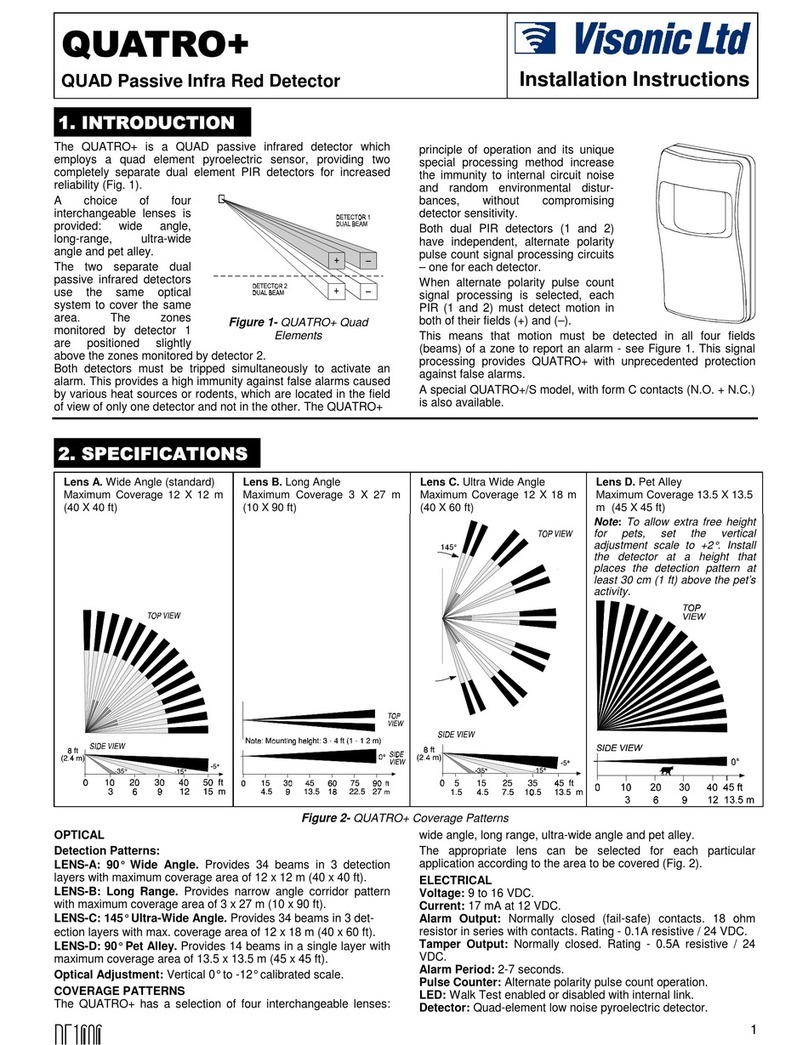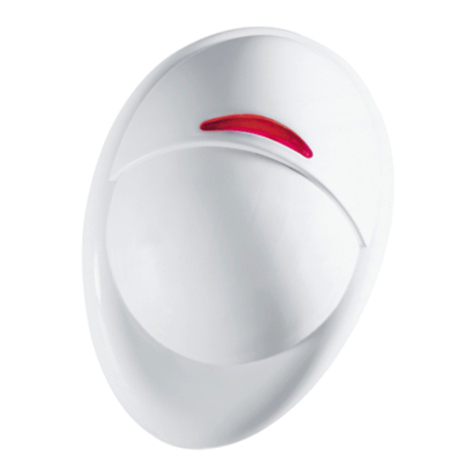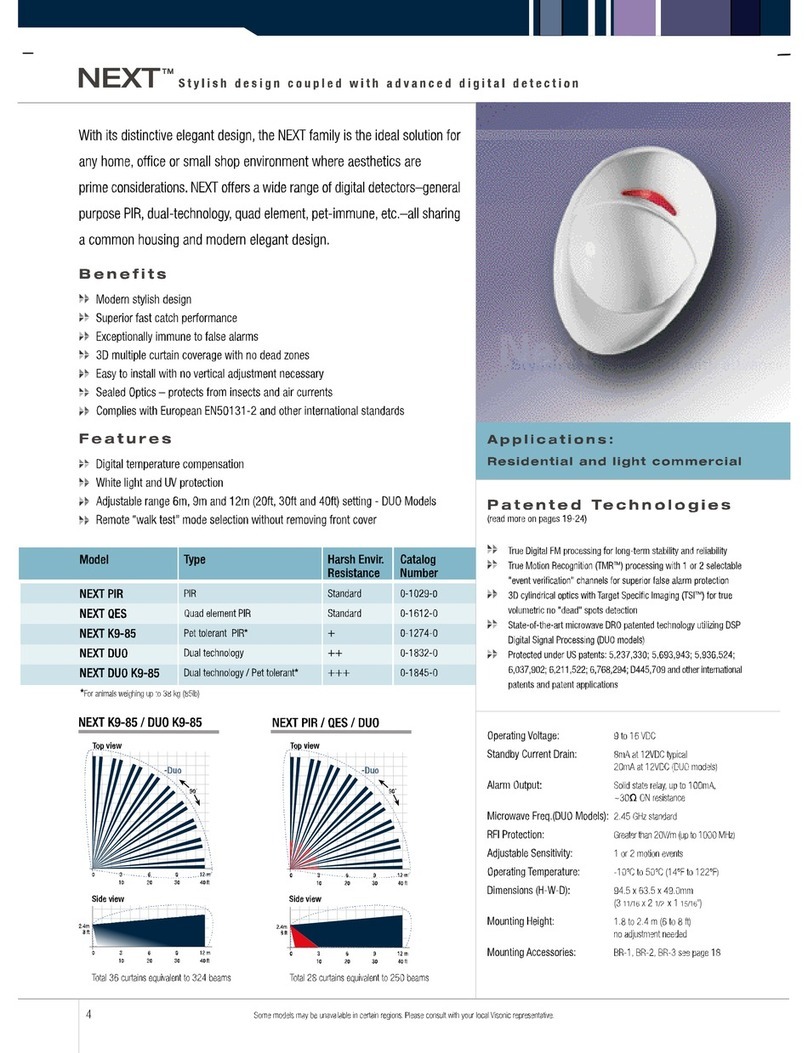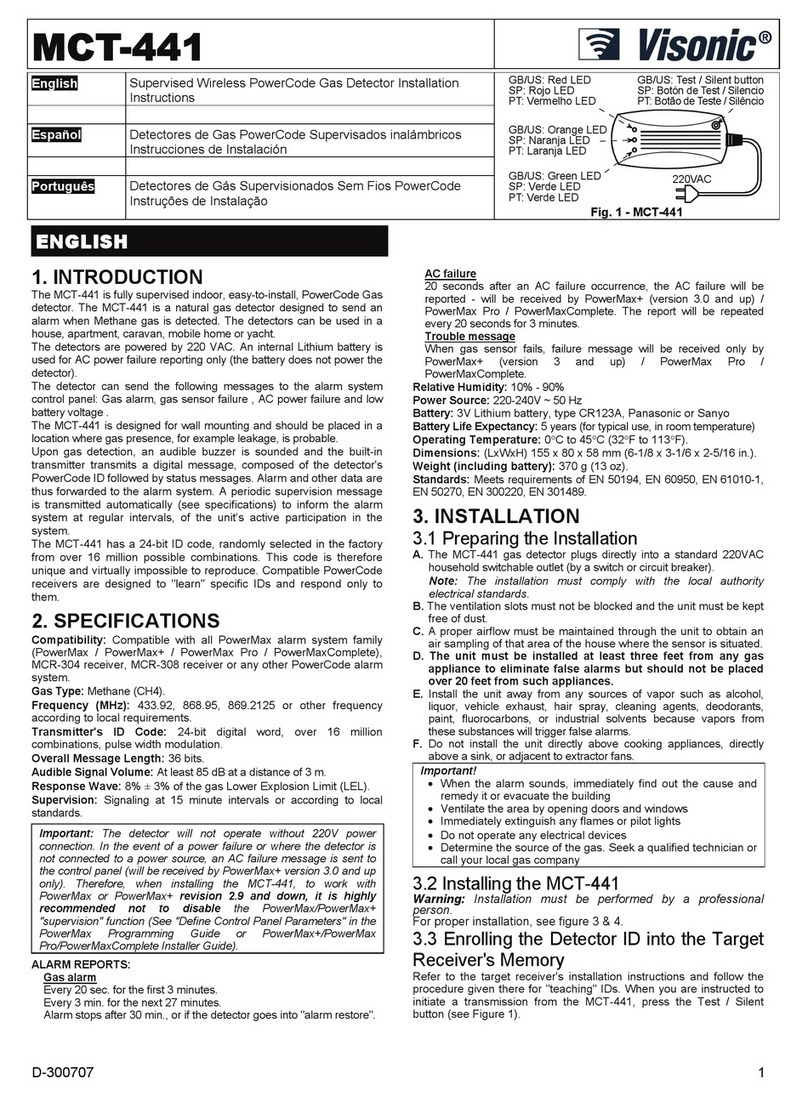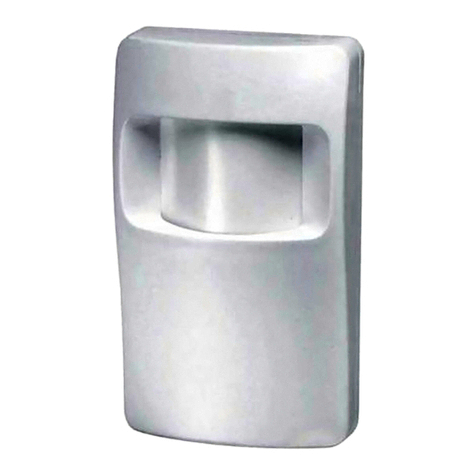4DE1842
Figure 13. Vertical Adjustment
B. Pet-Free Locations
To obtain the best coverage possible where no pets are present,
mount the detector with the integral bracket at any desired height
between 1.8 and 2.4 m (6 to 8 ft). Then set the vertical adjustment
scale to the 2.4 m (8 ft) position and tilt the detector 20°down.
3.9 Setting the Motion Event Counter
If you wish to set the PIR detector for maximum false alarm
immunity, shift DIP switch No. 1 (SW-1) to ON. In this position, two
consecutive motion events are required to trip the PIR detector. For
faster catch performance, shift SW-1 to OFF. In this position, only
one motion event is required to trip the PIR detector.
3.10 PIR Walk Test
A. Rotate the MW RANGE control fully counterclockwise to MIN.
B. Verify that DIP switch SW-2 is set to ON (the LED is enabled).
C. Mount the front cover in place.
D. Walk into the detector's field of view at the expected far edge
of the coverage area. The green light should flash for up to 5
seconds each time your motion is detected.
Note: If the green light glows steadily for up to 5 seconds,
your motion has been detected by the MW detector.
E. If PIR detection is not obtained at the far end of the coverage
area, remove the front cover and re-adjust the vertical
position. Replace the cover and retest.
3.11 MW Walk Test
A. Remove the front cover.
B. Verify that the MW RANGE control is set fully counterclockwise
to MIN and that DIP switch SW-2 is set to ON (LED is enabled).
C. Start by moving into the coverage area at the far edge. The
LED should light green for up to 5 seconds each time your
motion is detected.
D. If your motion was not detected at the far edge, advance the
MW RANGE control slightly clockwise toward MAX and try
again until your motion is detected reliably at the far edge.
Caution! The MW detection range must not exceed the far
edge of the desired coverage area.
E. Walk across the coverage area at various ranges and verify
that your motion is consistently detected.
Note: If PIR trips interfere with your test, disable the PIR by
inserting a small piece of cardboard in front of the sensor.
3.12 Alarm Walk Test
A. Set DIP switch SW-2 to ON (the LED is enabled).
B. Install the front cover in place.
C. Walk across the detector’s field of view in different directions,
at various distances from the detector, and verify proper
alarming throughout the detector's coverage area (the red
light glows for 1.3 to 5 seconds).
D. When done, remove the cover and set DIP switch SW-2 to
OFF to prevent unauthorized tracing of the coverage pattern.
E. Remount the cover and fasten it to the base using the small
screw at the bottom.
Attention! To assure proper function of the detector, the range
and coverage area should be checked at least twice a year.
Furthermore, it is recommended that users perform a walk test
at the far end of the coverage pattern to assure an alarm signal
prior to each time the alarm system is armed.
4
44
4. MISCELLANEOUS COMMENTS
. MISCELLANEOUS COMMENTS. MISCELLANEOUS COMMENTS
. MISCELLANEOUS COMMENTS
This device has been tested and found to comply with the limits for a
Class B digital device, pursuant to Part 15 of the FCC Rules. These
limits are designed to provide reasonable protection against harmful
interference in residential installations. This equipment generates,
uses and can radiate radio frequency energy and, if not installed and
used in accordance with the instructions, may cause harmful
interference to radio and television reception. However, there is no
guarantee that interference will not occur in a particular installation. If
this device does cause such interference, which can be verified by
turning the device off and on, the user is encouraged to eliminate the
interference by one or more of the following measures:
– Re-orient or re-locate the receiving antenna.
– Increase the distance between the device and the receiver.
– Connect the device to an outlet on a circuit different from the one
which supplies power to the receiver.
– Consult the dealer or an experienced radio/TV technician.
WARRANTY
WARRANTYWARRANTY
WARRANTY
Visonic Ltd. and/or its subsidiaries and its affiliates ("the Manufacturer") warrants its
products hereinafter referred to as "the Product" or "Products" to be in conformance with
its own plans and specifications and to be free of defects in materials and workmanship
under normal use and service for a period of twelve months from the date of shipment by
the Manufacturer. The Manufacturer's obligations shall be limited within the warranty
period, at its option, to repair or replace the product or any part thereof. The Manufacturer
shall not be responsible for dismantling and/or reinstallation charges. To exercise the
warranty the product must be returned to the Manufacturer freight prepaid and insured.
This warranty does not apply in the following cases: improper installation, misuse,
failure to follow installation and operating instructions, alteration, abuse, accident or
tampering, and repair by anyone other than the Manufacturer.
This warranty is exclusive and expressly in lieu of all other warranties, obligations or
liabilities, whether written, oral, express or implied, including any warranty of
merchantability or fitness for a particular purpose, or otherwise. In no case shall the
Manufacturer be liable to anyone for any consequential or incidental damages for breach
of this warranty or any other warranties whatsoever, as aforesaid.
This warranty shall not be modified, varied or extended, and the Manufacturer does not
authorize any person to act on its behalf in the modification, variation or extension of this
warranty. This warranty shall apply to the Product only. All products, accessories or
attachments of others used in conjunction with the Product, including batteries, shall be
covered solely by their own warranty, if any. The Manufacturer shall not be liable for any
damage or loss whatsoever, whether directly, indirectly, incidentally, consequentially or
otherwise, caused by the malfunction of the Product due to products, accessories, or
attachments of others, including batteries, used in conjunction with the Products.
The Manufacturer does not represent that its Product may not be compromised and/or
circumvented, or that the Product will prevent any death, personal and/or bodily injury
and/or damage to property resulting from burglary, robbery, fire or otherwise, or that the
Product will in all cases provide adequate warning or protection. User understands that a
properly installed and maintained alarm may only reduce the risk of events such as
burglary, robbery, and fire without warning, but it is not insurance or a guarantee that such
will not occur or that there will be no death, personal damage and/or damage to property
as a result.
The Manufacturer shall have no liability for any death, personal and/or bodily injury
and/or damage to property or other loss whether direct, indirect, incidental,
consequential or otherwise, based on a claim that the Product failed to function.
However, if the Manufacturer is held liable, whether directly or indirectly, for any loss or
damage arising under this limited warranty or otherwise, regardless of cause or origin, the
Manufacturer's maximum liability shall not in any case exceed the purchase price of the
Product, which shall be fixed as liquidated damages and not as a penalty, and shall be the
complete and exclusive remedy against the Manufacturer.
Warning: The user should follow the installation and operation instructions and among
other things test the Product and the whole system at least once a week. For various
reasons, including, but not limited to, changes in environmental conditions, electric or
electronic disruptions and tampering, the Product may not perform as expected. The user
is advised to take all necessary precautions for his/her safety and the protection of his/her
property.
6/91
VISONIC LTD. (ISRAEL): P.O.B 22020 TEL-AVIV 61220 ISRAEL. PHONE: (972-3) 645-6789, FAX: (972-3) 645-6788
VISONIC INC. (U.S.A.): 10 NORTHWOOD DRIVE, BLOOMFIELD CT. 06002-1911. PHONE: (860) 243-0833, (800) 223-0020 FAX: (860) 242-8094
VISONIC LTD. (UK): UNIT 1, STRATTON PARK, DUNTON LANE, BIGGLESWADE, BEDS. SG18 8QS. PHONE: (01767) 600857 FAX: (01767) 601098
INTERNET: www.visonic.com
VISONIC LTD. 2000 K-980D DE1842- (REV. 1, 3/00)
